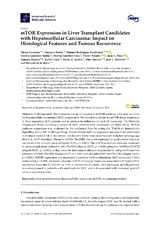Mostrar el registro sencillo del ítem
mTOR Expression in Liver Transplant Candidates with Hepatocellular Carcinoma: Impact on Histological Features and Tumour Recurrence
| dc.contributor.author | Guerrero, Marta | |
| dc.contributor.author | Ferrín, Gustavo | |
| dc.contributor.author | Rodríguez-Perálvarez, Manuel | |
| dc.contributor.author | González Rubio, Sandra | |
| dc.contributor.author | Sánchez-Frías, Marina | |
| dc.contributor.author | Amado-Torres, Víctor | |
| dc.contributor.author | Pozo, Juan C. | |
| dc.contributor.author | Poyato, Antonio | |
| dc.contributor.author | Ciria, Rubén | |
| dc.contributor.author | Ayllón Terán, M. Dolores | |
| dc.contributor.author | Barrera, Pilar | |
| dc.contributor.author | Montero, José L. | |
| dc.contributor.author | Mata, Manuel de la | |
| dc.date.accessioned | 2019-02-25T13:11:16Z | |
| dc.date.available | 2019-02-25T13:11:16Z | |
| dc.date.issued | 2019 | |
| dc.identifier.uri | http://hdl.handle.net/10396/17955 | |
| dc.description.abstract | (1) Background: The mammalian target of rapamycin (mTOR) pathway activation is critical for hepatocellular carcinoma (HCC) progression. We aimed to evaluate the mTOR tissue expresión in liver transplant (LT) patients and to analyse its influence on post-LT outcomes. (2) Methods: Prospective study including a cohort of HCC patients who underwent LT (2012–2015). MTOR pathway expression was evaluated in the explanted liver by using the “PathScan Intracellular Signalling Array Kit” (Cell Signalling). Kaplan-Meier and Cox regression analyses were performed to evaluate post-LT HCC recurrence. (3) Results: Forty-nine patients were included (average age 56.4 _ 6, 14.3% females). Phospho-mTOR (Ser2448) was over-expressed in peritumoral tissue as compared with tumoral tissue (DSignal 22.2%; p < 0.001). The mTOR activators were also increased in peritumoral tissue (phospho-Akt (Thr308) DSignal 18.2%, p = 0.004; phospho-AMPKa (Thr172) DSignal 56.3%, p < 0.001), as they were the downstream effectors responsible for cell growth/survival (phospho-p70S6K (Thr389) DSignal 33.3%, p < 0.001 and phospho-S6RP (Ser235/236) DSignal 54.6%, p < 0.001). MTOR expression was increased in patients with multinodular HCC (tumoral p = 0.01; peritumoral p = 0.001). Increased phospho-mTOR in tumoral tissue was associated with higher HCC recurrence rates after LT (23.8% vs. 5.9% at 24 months, p = 0.04). (4) Conclusion: mTOR pathway is over-expressed in patients with multinodular HCC and is it associated with increased post-LT tumour recurrence rates. | es_ES |
| dc.format.mimetype | application/pdf | es_ES |
| dc.language.iso | eng | es_ES |
| dc.publisher | MDPI | es_ES |
| dc.rights | https://creativecommons.org/licenses/by/4.0/ | es_ES |
| dc.source | International Journal of Molecular Sciences 20(2), 336 (2019) | es_ES |
| dc.subject | Liver transplantation | es_ES |
| dc.subject | Hepatocellular carcinoma | es_ES |
| dc.subject | mTOR | es_ES |
| dc.subject | Immunosuppression | es_ES |
| dc.title | mTOR Expression in Liver Transplant Candidates with Hepatocellular Carcinoma: Impact on Histological Features and Tumour Recurrence | es_ES |
| dc.type | info:eu-repo/semantics/article | es_ES |
| dc.relation.publisherversion | http://dx.doi.org/10.3390/ijms20020336 | es_ES |
| dc.relation.projectID | Instituto de Salud Carlos III. FIS PI11-02867 | es_ES |
| dc.relation.projectID | Instituto de Salud Carlos III. FIS PI14/01469 | es_ES |
| dc.rights.accessRights | info:eu-repo/semantics/openAccess | es_ES |

